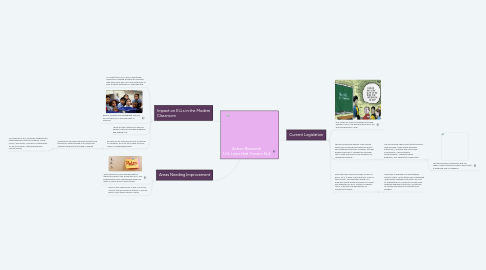
1. Current Legislation
1.1. Due to the No Child Left Behind act being passed in 2002, the Bilingual Education Act was relinquished in 1968.
1.2. This would normally appear to be a good thing. One act being eliminated because a new standard has arrives. However, this was problem because it changes the verbiage that is used and places more emphasis on "adequate progress."
1.2.1. The terminology that school districts would read included: “high quality language instruction,” “parental and community involvement,” “demonstrated improvements,” “adequate yearly progress,” and “flexibility to implement.”
1.2.1.1. This terminology is subjective and too vague. It gives little information about what is expected and no guidance.
1.3. After the Every Child Succeeds Act was in place, 2010, it gave school districts a run for their money. The legislation wrote a 40 page document giving information on what was expected for ELLs. Written in lawyers terms, instead of the perspective of classroom teachers.
1.3.1. There was a large gap in understanding state-to-state. Some states have interpreted “high quality language instruction” as a call to segregate ELLs in order to provide more targeted language instruction, sometimes as immersive English and sometimes as bilingual.
2. Impact on ELLs in the Modern Classroom
2.1. In current times, ELLs are in mainstream classrooms. Helping students be included with their peers and use a special teacher to help students with gaps in understanding.
2.2. Before, student were segregated and due to civil rights, ELLs are now apart of inclusion.
2.3. There are two methods of learning English. There are bilingual programs and English only.
2.4. Because of the immense amount of testing for students, ELLs are more likely to score lower on standardized tests.
2.4.1. These tests are biased because the tests are testing for understanding of a culture and mindset along with only being in English.
2.4.1.1. For students in ELA, students struggle with understanding cultural boundaries, social norms, and history. This test is catastrophic for ELLs because of the language and cultural barrier.

